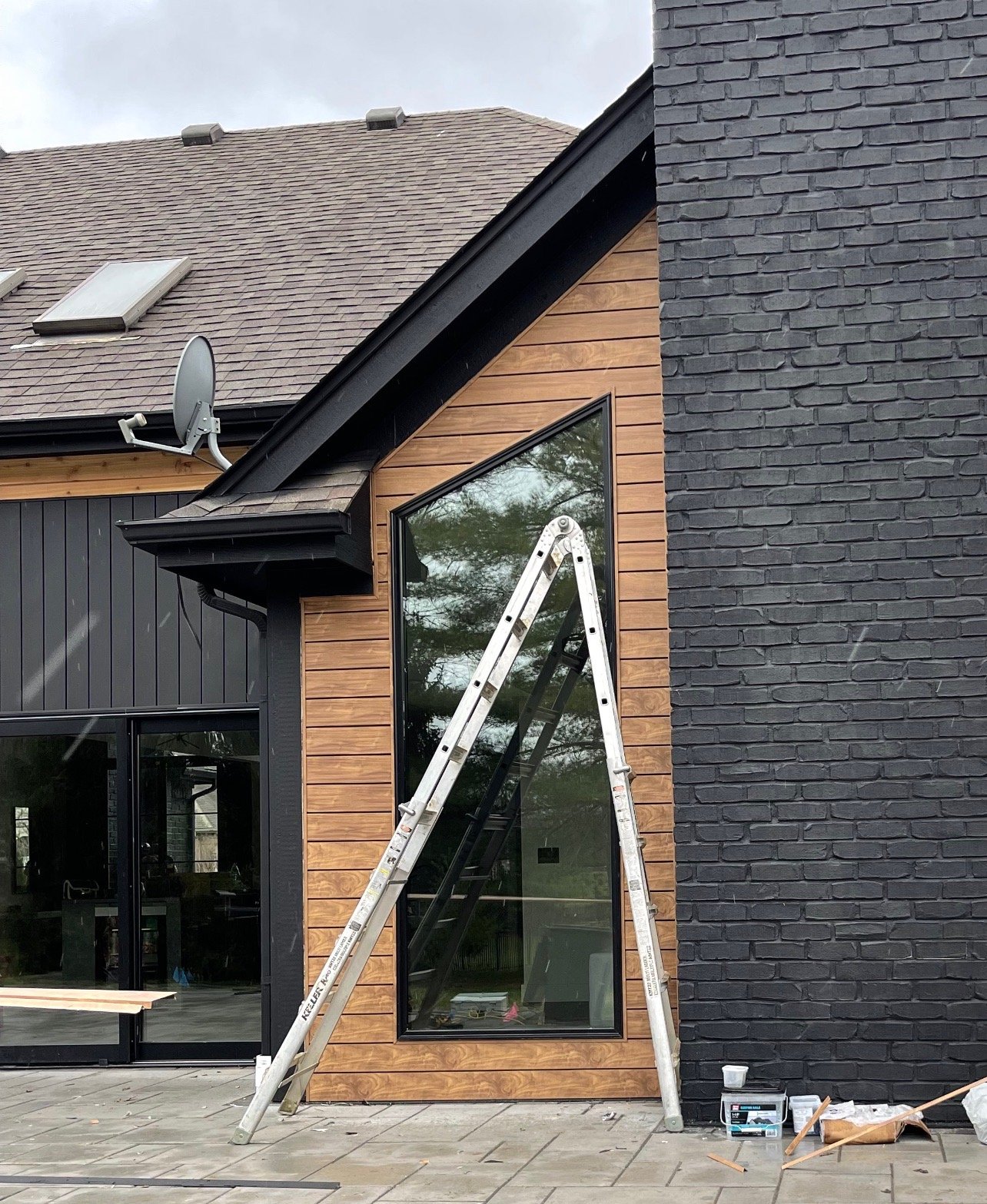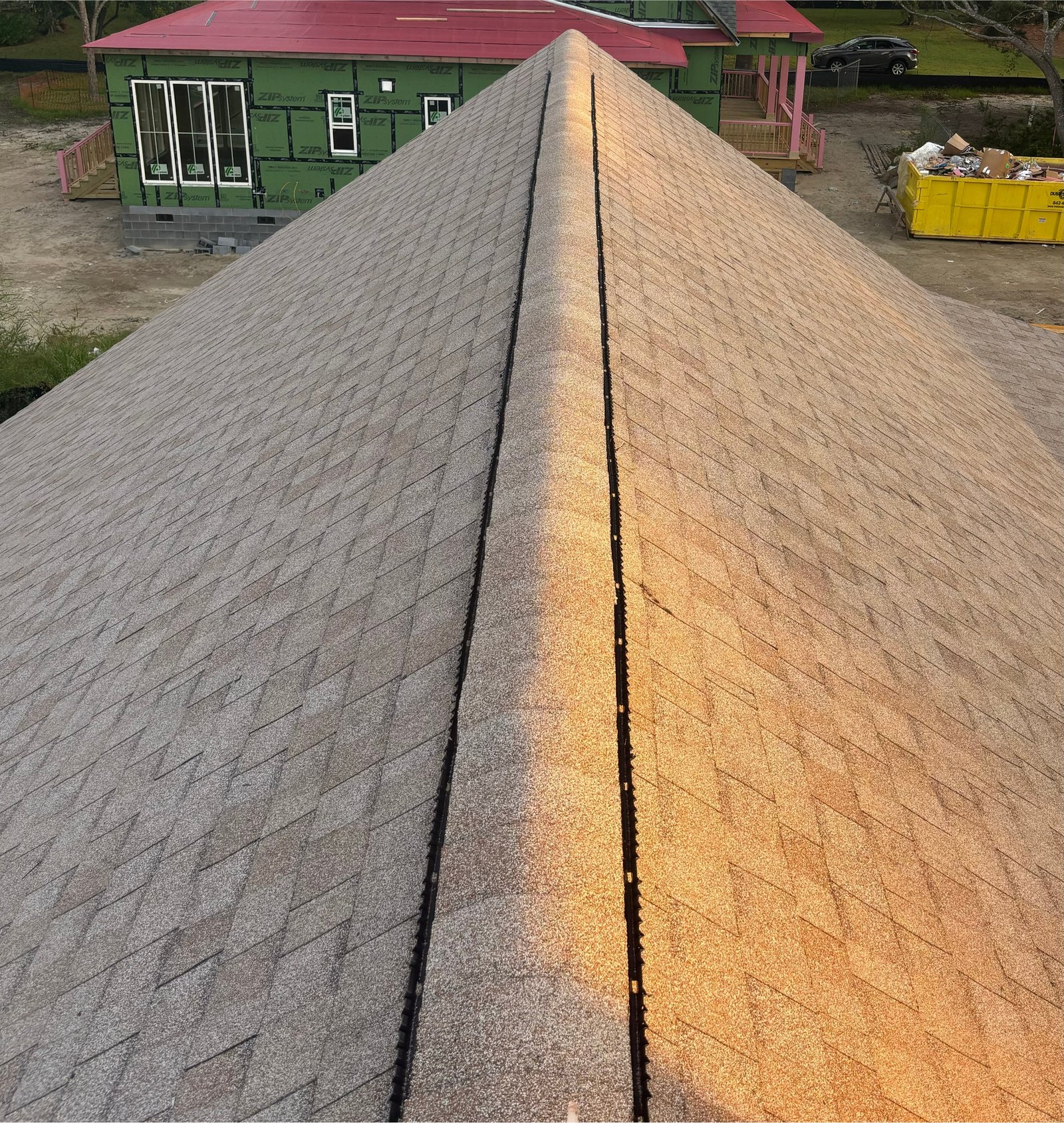Everlast Installation Documents and Videos Here:
1. Tear Off and Wall Preparation:
- *Tear Off and Inspect the Substrate*: Tear off existing siding to the wood substrate and ensure the substrate is flat, nailable, and free from rot. Repair any damaged wall sheathing if necessary prior to installing house wrap.
- *Install House Wrap and Fan-Fold (If Necessary)*: Fasten house wrap with cap nails to the wood substrate to provide a moisture barrier. Overlap seams by about 6 inches and tape them with house wrap seam tape. Fan-Fold insulation barriers can also be installed prior to installing the siding to help even the wall surface in areas where it may not be completely level.
- *Install Flashing*: Install z-flashing (head flashing) and other cap flashings around doors, windows, and other openings to prevent water infiltration. Apply the seam tape around the flashings for double protection.
- *Capping Windows with Aluminum*: Sometimes, installing aluminum capping around existing wood window trim is ideal for homeowners for aesthetic reasons. This is a field formed action performed on site with a metal brake so that the capping fits exactly to the size of the trim.
2. Installing the Starter Strip:
- *Mark the Level Line*: Use a chalk line to mark a level line around the base of the wall, 3.5” above the foundation/substrate termination at the lowest point of the wall such that the siding overhangs the foundation/sheathing transition by ½”. Must be nailed every 8-16” apart along the strip in the center parts of the nailing flanges
- *Attach the Starter Strip*: Position the starter strip along the level line and nail it in place, leaving a 1/32 inch gap between nails and the starter strip to allow for expansion. There should also be a 1/2” space between the strips to allow for expansion as well as 1”- 4” from the corner posts nailing flange.
- *Elevation Changes on Walls*: In certain situations, it may be necessary to use J-Channel as a starter strip when the wall changes elevation. (Around stone, sloped elevations, etc.) Drill a minimum 3/16” weep holes at most 24” apart to allow for water drainage.
3. Install Inside and Outside Corner Posts:
- *Position and Fastening Corner Posts*: Place the corner posts at each corner of the house, both inside and outside corners, ensuring they extend ¾” below the bottom of the starter strip to the eaves. There should be a ¼” space between the top of the corner post and the bottom of the soffit. The top most nail needs to be fastened in the top most nailing flange in the top most position of the flange of that corner posts. Must be nailed every 8-12” apart along the nailing flanges in the middle of the slots (except the top most flange, that nail needs to be in the upper most section of that flange so that the corner post can only expand upwards. The corner post should also sit ¾” below the bottom of the starter strip.
- *Installing Outside Corners on 2-Story Homes*: Install your first corner regularly to spec. For the second course, install flush and use a seam bracket blindly fastened to ensure the corners remain tight at the seams during expansion and contraction. (Longer Everlast 20-foot corners can be purchased for a consistent, no seamed, look for the outside corners.)
4. Install J-Channel/Lineals/J-Blocks Around Openings:
- *Measure and Cut*: Measure and cut J-channel/Lineals to fit around windows, doors, and other openings. Miter the corners for a clean fit and ensure proper cut techniques are used at miters to prevent water penetration.
- *Attach J-Channel/Lineals*: Nail the J-channel around the openings, ensuring it is level and properly aligned. Must be fastened every 8-12” apart in the center of the flanges so that it can expand and contract. L-Brackets should be used on the J-channel to ensure the miters do not separate. Although Everlast does not specify this to be done, it is crucial to keep a clean seamless look at the mitered corners of the J-channel. When installing lineals, a specific 1x1 piece of wood blocking is required to be installed behind the lineal, in the fabricated cavity, and fastened together to keep a seamless look at the miters. Please see Everlast trim installation requirements for each specific type of trim as they all have different blocking requirements.
- *Install J-Blocks*: Around electrical outlets, switches, hoses, light fixtures, dryer vents, etc. These vinyl blocks should be customer ordered from the supplier based on the Everlast color codes. As an alternative, PVC can be used to custom fabricate trim around these areas.
5. Install the Siding Panels:
- *Start at the Bottom*: Begin with the first panel, locking it into the starter strip and nailing it into place. Leave a 1/32 inch gap (or thickness of a dime) between the nail head and the panel to allow for expansion and contraction. Make sure to keep a ¼” gap in channel trims to ensure the panel can expand and contract.
- *Butt Panels*: When installing subsequent panels, butt seams, ensuring seams are staggered for better appearance, durability, and to meet manufacturer specifications. Seams should be staggered at least 2 studs away, or 32” for 16” on center wall framing.
- *Check for Level*: Regularly check that the panels are level as you work your way up the wall. Due to Everlast have a lip on the backside, this isn’t really required as it inevitably ensures the panels remain level.
- *Cut Panels as Needed*: Measure and cut panels to fit around windows, doors, and other openings, using snips or a utility knife. Make sure to keep ¼” space to allow for expansion and contraction.
- *Fasten to Studs*: Everlast Lap Siding needs to be nailed in the center of the nail flanges and into the wall studs. Siding should not be hung solely to the wood substrate. The siding nails must be long enough to penetrate at least ¾ inch into the studs. (Through the siding flange, the fan fold, the substrate, and into the stud)
Installing Vertical Board and Batten Siding:
- *Center Left and Right Most Panels*: Measure the length of the wall, convert to inches (multiply by 12), then divide by the reveal of the panel. This will give you the total number of panels required to do the wall. Split the difference on the first and last panel so that the wall is aesthetic and proportionate. If this calculation is not done, the space at the leftmost panel from the corner/termination point will not be identical to the space at the rightmost panel from its corner/termination point.
- *Installing Board and Batten Panels*: When installing the panels for board and batten, you must fasten the panel in the center of the nailing flanges except for the uppermost nailing flange. This uppermost nailing flange needs the placement of the nail at the uppermost part of the nailing flange to ensure the panel only moves upwards when it expands. This is the same concept as vinyl board and batten. The expansion cuts also need to be ¼ inch. Board and Batten panels must be fastened into wall sheathing at least 7/16” thick and must penetrate the sheathing by ¾”.
6. Install Utility Trim:
- *Under Eaves and Around Windows for Horizontal Siding*: Use blocking pieces under eaves at the top of walls and underside of windows and other openings. This “furs” the cut piece of siding into place within the channel, such that it appears tight. If blocking is not used, the panel will eventually fall out since the cut panel doesn’t have a nail flange. Sometimes, installers will “face nail” these pieces. This “face nailing” prevents the panel from expanding and contracting and therefore eventually leads to buckling. In order to fit this piece of siding inside the channel, installers must trim off 1/8” on the lip on the back of the panel so that it can fit in the trim pocket.
- *On Each End (Corners/Terminations) Inside Channel Trim for Vertical Siding*: When installing vertical siding, utility trim is to be installed on the ends so that the cut pieces of siding are locked on at the ends.
7. Clean Up, Magnet Sweep, Final Inspection
- *Inspect Your Work*: Ensure all panels and trim pieces are clean.
- *Clean Up*: Remove any debris, magnet sweep for all nails, double check flower/mulch/grass/walkways and ensure the area is cleaner than when arrived to do the project.
- *Walk Around with Homeowners*: Perform final walk around to ensure work is completed to homeowner satisfaction and to answer any potential questions.
Helpful Vinyl Siding Install Tips:
- *Allow for Expansion and Contraction*: Vinyl siding expands and contracts with temperature changes. Always leave a small gap between the nails and the siding to allow for this movement. This gap must be 1/32” and the cuts must be ¼” spaced inside the channels around trim to ensure the panels can move.





